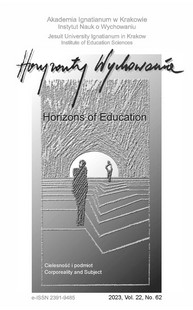Zastosowanie Dance/Movement Therapy (DMT) u osób doświadczających traumy
Deploying Dance/Movement Therapy (DMT) in Persons Experiencing Trauma
Author(s): Renata OpałkaSubject(s): Individual Psychology, Cognitive Psychology, Behaviorism, Methodology and research technology, Victimology
Published by: Uniwersytet Ignatianum w Krakowie
Keywords: trauma; embodiment; dance-movement therapy; sexual abuse; refugees;
Summary/Abstract: RESEARCH OBJECTIVE: The scientific aim of this article is to present literature regarding physical components of trauma and possibility of treatment using Dance/Movement Therapy (DMT). THE RESEARCH PROBLEM AND METHODS: The main research problem is the issue of DMT intervention and the use of DMT in treating physical components of trauma. The method is the analysis of chosen literature. THE PROCESS OF ARGUMENTATION: DMT’s effectivity is analysed on the based of research conducted in groups of sexual abuse victims and children refugees. In these groups DMT appeared to have positive results for participants. Then, the advantages and limitations of this method are discussed. RESEARCH RESULTS: Trauma causes dysregulation in the whole body. Dance based therapy in treating physical components of excessive stress is an interesting area of research. DMT can be an effective addition to trauma intervention. DMT is a method already used in therapeutic practice. Conducted research showed that DMT has positive results. CONCLUSIONS, INNOVATIONS, AND RECOMMENDATIONS: Body based treatment in context of trauma should be still explored. Creating DMT manual and scientific measurement tools could help to confirm its effectivity. It can be an interesting alternative in Poland for treating Russian invasion victims.
Journal: Horyzonty Wychowania
- Issue Year: 22/2023
- Issue No: 62
- Page Range: 95-105
- Page Count: 11
- Language: Polish

